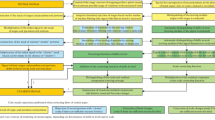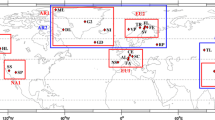Abstract
Temperature was monitored as a function of time at several selected depth levels in a slim experimental borehole. The hole is 15 cm in diameter, 150 m deep, and effectively sealed from the influx of ground water by a plastic tube of 5 cm diameter. The mean temperature gradient is 19.2 mK/m. The borehole was drilled in 1993 and has been in equilibrium since then. The data obtained reveal that: (1) the temperature-time series showed a complex, apparently random oscillation pattern with amplitudes of up to 25 mK; (2) irregular temperature variations characterized by larger oscillations may alternate with relatively “quiet” intervals; and (3) the character of the oscillation may vary both in depth as well as in time and the transition between two distinct regimes may be sudden.
The Fourier analysis detected “red noise” behavior of the signal but did not highlight any specific peak(s) corresponding to periodicity in the measured temperature series. We employed a variety of techniques (roughness coefficient, local growth of the second moment, recurrence and cross recurrence plots) to reveal the deterministic framework of the system behavior. All above methods were proven to be quite robust in the face of noise, and enabled the discovery of structures hidden in the signals produced by complex natural processes.
Statistical analysis suggested the existence of a quasi-periodic intra-hole oscillatory convection. The temperature field in the hole has a dual-frequency structure, in which short period oscillations of about 10–30 minutes are superposed on longer variations of up to several hours. At certain conditions, so far not fully understood, the temperature oscillations may practically stop. The temperature remains within 1–2 mK for a period of several days when the oscillation pattern (convection ?) suddenly resumes.
Similar content being viewed by others
References
Behzinger R.P. and Ahlers G., 1982. Heat transport and temporal evolution of fluid flow near the Rayleigh-Bénard instability in cylindrical containers. J. Fluid Mech., 125, 219–258.
Bodri L. and Čermák V., 2005. Miltifractal analysis of temperature time series: Data from boreholes in Kamchatka. Fractals, 13, 299–310.
Čermák V., Šafanda J., Krešl M. Dědeček P. and Bodri L., 2000. Recent climate warming: Surface air temperature series and geothermal evidence. Stud. Geophys. Geod., 44, 430–441.
Čermák V., Šafanda J., Bodri L., Yamano M. and Gordeev E., 2006. A comparative study of geothermal and meteorological records of climate change in Kamchatka. Stud. Geophys. Geod., 50, 674–695.
Čermák V., Šafanda J. and Bodri L., 2007a. Precise temperature monitoring in boreholes: evidence for oscillatory convection? Part I. Experiments and field data. Int. J. Earth Sci. (Geol. Rundsch.), doi: 10.1007/s00531-007-0237-4.
Čermák V., Bodri L. and Šafanda J., 2007b. Precise temperature monitoring in boreholes: evidence for oscillatory convection? Part II. Theory and interpretation. Int. J. Earth Sci. (Geol. Rundsch.), doi: 10.1007/s00531-007-0250-7.
Diment W.H., 1967. Thermal regime of a large diameter borehole: instability of the water column and comparison of air-and water-filled conditions. Geophysics, 32, 720–726.
Ecke R. and Haucke H., 1989. Noise-induced intermittency in the quasiperiodic regime of Rayleigh-Bénard convection. J. Stat. Phys., 54, 1153–1172.
Eckmann J.-P., Kamphorst S. and Ruelle D., 1987. Recurrence plots of dynamical systems. Europhys. Lett., 4, 973–977.
Garland G.D. and Lennox D.H., 1962. Heat flow in Western Canada. Geophys. J., 6, 245–262.
Ghil M. and Yiou P., 1996. Spectral methods: what they can and cannot do for climatic time series. In: Anderson D. and Willebrand J. (Eds.), Decadal Climate Variability: Dynamics and Predictability. Elsevier, Amsterdam, The Netherlands, 446–482.
Gilman D.L., Fuglister F.J. and Mitchell Jr., J.M., 1963. On the power spectrum of “Red Noise”. J. Atmos. Sci., 20, 182–184.
Gretener P.E., 1967. On the thermal instability of large diameter wells-an observational report. Geophysics, 32, 727–738.
Haenel R., Rybach L., and Stegena L., (Eds), 1988. Handbook of Terrestrial Heat-Flow Density Determinations. Kluwer Academic Publishers, London, U.K.
Hales A.L., 1937. Convection currents in Geysers. Mon. Not. Roy. Astr. Soc., Geophys. Suppl., 4, 122–131.
Hasselmann K., 1976. Stochastic climate models. Part I. Theory. Tellus, XXVIII, 473–485.
Hastings H.M. and Sugihara G., 1993. Fractals. A User’s Guide for the Natural Sciences. Oxford Univ. Press, Oxford, U.K.
Koster J.N. and Müller U., 1984. Oscillatory convection in vertical slots. J. Fluid. Mech., 139, 36–390.
Lee Y. and Korpela S.A., 1970. Multicellular natural convection in a vertical slots. J. Fluid. Mech., 42, 125–127.
Mandelbrot B.B., 1982. The Fractal Geometry of Nature. Freeman and Co, New York.
Mandelbrot B.B. 1999. Multifractals and 1/f Noise: Wild Self-Affinity in Physics (1963–1976). Springer-Verlag, New York.
Marwan N. and Kurths J., 2002. Nonlinear analysis of bivariate data with cross recurrence plots. Phys. Lett. A, 302, 299–307.
Marwan N. and Kurths J., 2005. Line structures in recurrence plots. Phys. Lett. A, 336, 349–357.
Marwan N., Thiel M. and Nowaczyk N.R., 2002a. Cross recurrence plot based synchronization of time series. Nonlinear Process. Geophys., 9, 325–331.
Marwan N., Wessel K., Meyerfeldt U., Schirdewan A. and Kurts J., 2002b. Recurrence-plot-based measures of complexity and their application to heart-rate-variability data. Phys. Rev. E, 66, 026702.
Misener A.D. and Beck A.E., 1960. The measurements of heat flow over land. In: Runkorn S.K. (Ed.), Methods and Techniques in Geophysics, Vol.1. Interscience Publishing, New York, 10–61.
Šafanda J., 1994. Effects of topography and climatic changes on the temperature in borehole GFU-1, Prague. Tectonophysics, 239, 187–197.
Štulc P., 1995. Return to thermal equilibrium of an intermittently drilled hole: theory and experiment. Tectonophysics, 241, 35–45.
Tritton D.J., 1977. Physical Fluid Dynamics. Van Nostrand Reinhold Company, New York.
Turcotte D.L., 1992. Fractals and Chaos in Geology and Geophysics. Cambridge Univ. Press, New York.
Vest C.M. and Arpaci V.S., 1969. Stability of natural convection in a vertical slot. J. Fluid Mech., 36, 1–15.
Zbilut J., Giuliani A. and Webber C., 1998a. Recurrence quantification analysis and principal components in the detection of short complex signals. Phys. Lett. A, 237, 131–135.
Zbilut J., Giuliani A. and Webber C., 1998b. Detecting deterministic signals in exceptionally noisy environments using cross-recurrence quantification. Phys. Lett. A, 246, 122–128.
Author information
Authors and Affiliations
Corresponding author
Rights and permissions
About this article
Cite this article
Čermák, V., Šafanda, J. & Krešl, M. High resolution temperature monitoring in a borehole, detection of the deterministic signals in noisy environment. Stud Geophys Geod 52, 413–437 (2008). https://doi.org/10.1007/s11200-008-0029-8
Received:
Revised:
Accepted:
Published:
Issue Date:
DOI: https://doi.org/10.1007/s11200-008-0029-8




